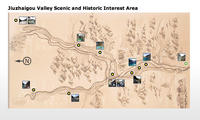You are in: Asia -> China -> Jiuzhaigou Valley Sc... , and traditional search or Image Gallery will yield results of this site only
Jiuzhaigou Valley Scenic and Historic Interest Area
| Site number: | 637 |
|
| Type of site: | Natural | |
| Date of Inscription: | 1992 | |
| Location: | Asia, China, Nanping County, Sichuan Province | |
Up to 75 images are shown here. Click on each for more details or on Image Gallery for more images.
| Description: | The jagged Jiuzhaigou valley reaches a height of more than 4,800 m and stretches over 72,000 ha in the northern part of Sichuan Province, thus encompassing a series of diverse forest ecosystems. Its fantastic landscapes are particularly interesting with their composition of conic karst land forms and stunning waterfalls. A number of endangered plant and animal species reside in the valley, among them the giant panda and the Sichuan takin; also some 140 bird species find home here. --WHMNet paraphrase from the description at WHC Site, where additional information is available. For 360 degree imaging of this site, click here. | |
| Jiuzhaigou Valley is a nature reserve in northern Sichuan province of China. It is known for its many multi-level waterfalls and colorful lakes, and was declared a UNESCO World Heritage Site in 1992. It belongs to the category V (Protected Landscape)in the IUCN system of protected area categorization. Jiuzhaigou is composed of three valleys arranged in a Y shape. The Rize and Zechawa gullies flow from the south and meet at the centre of the site where the form the Shuzheng gully, flowing north to the mouth of the valley. The mountainous watersheds of these gullies are lined with 55 km of roads for shuttle buses, as well as boardwalks and small pavilions. The boardwalks are typically located on the opposite side of the lakes from the road, shielding them from disturbance by passing buses. Most visitors will first take the shuttle bus to the end of Rize and/or Shuzheng gully, then make their way back downhill by foot on the boardwalks, taking the bus instead when the next site is too distant. Here is a summary of the sites found in each of the gullies. The remote region was inhabited by various Tibetan and Qiang peoples for centuries, but was not officially discovered by the government until 1972. Extensive logging took place until 1979, when the Chinese government banned such activity and made the area a national park in 1982. An Administration Bureau was established and the site officially opened to tourism in 1984; layout of facilities and regulations were completed in 1987. The site was inscribed by UNESCO as a World Heritage Site in 1992 and a World Biosphere Reserve in 1997. --Wikipedia. Text is available under the Creative Commons Attribution-ShareAlike License. For 360 degree imaging of this site, click here. | ||
| Source: | http://whc.unesco.org/en/list/637 | |
| Source2: | http://whc.unesco.org/en/list/637/video | |
| Reference: | 1. UNESCO World Heritage Center, Site Page. | |












































































